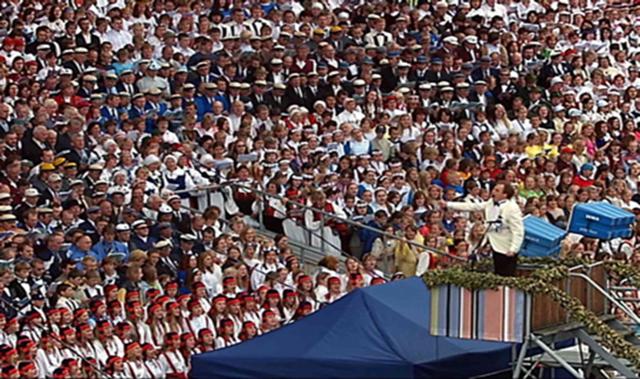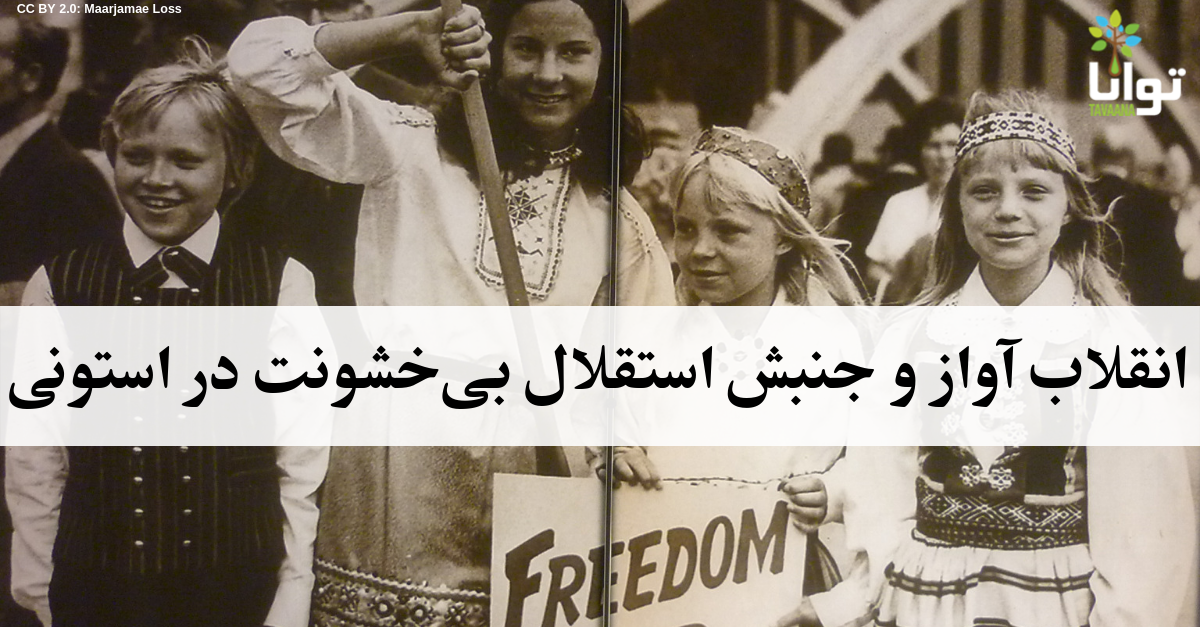Vision and Motivation
In 1869, Estonians gathered in the capital city of Tallinn for a national song festival, or Laulipudu. The songs they sang are cherished aspects of Estonian identity, and the festival became an annual tradition. During Soviet rule (1940-1991), Estonians used this song festival to assert their national identity. Soviet censorship formally limited the songs to those praising Marxism and other approved themes, but Estonians occasionally slipped into traditional patriotic songs.
Drawing on this tradition, Estonians in 1988 turned song festivals and concerts into a series of national protests against Soviet domination and the Singing Revolution began. Peaceful mass demonstrations featuring the singing of patriotic songs sparked a movement that over the next three years turned the dream of independence into a reality. The movement advanced public debate on independence, spurred the formation of new civic and political organizations, gained the support of the Estonian Communist leadership, and eventually led to independence in 1991.

National Song Festival Grounds, Tallinn
Leadership
At first, Estonians were divided between achieving autonomy within the Soviet Union and working towards complete independence. But they were united in seeking freedom of expression, exposing Soviet falsification of the history of the occupation and getting out from under Soviet cultural, political and economic control.
Three groups played major roles in propelling the independence movement forward. The Estonian Heritage Society (EHS) appeared first, founded in 1987. Their strategy was to educate Estonians about the country’s history to build support for freedom and self-governance. Their goal was complete independence, which was unimaginable to most Estonians at the time. Next, the centrist Popular Front of Estonia (PFE), was created in April 1988 by a former government planning minister. The PFE initially proposed autonomy within a loose Soviet confederation, but later shifted support to independence through gradual reforms. Lastly, in August 1988 the Estonian National Independence Party (ENIP) was organized by former political prisoners, human rights activists, intellectuals and independent youth groups. ENIP demanded full independence from the Soviet Union and wanted to restore the post-World War I Republic of Estonia.
All of these groups were committed to non-violence and frequently collaborated with each other in organizing rallies. However, tension between the organizations flared as some claimed collaboration with the Communist government was betrayal and centrists feared moving too aggressively towards independence would provoke a Soviet crackdown. The PFE was the standard bearer for moderate, negotiated reform from within, which was the position supported by the majority of Estonians.
In response to the Singing Revolution, some ethnic Russians living in Estonia formed anti-independence organizations ranging from moderate to extreme. The political struggle remained non-violent, despite provocations. The climax came in May 1990, when ethnic Russian protesters stormed the Estonian parliament after it adopted measures favoring independence. In response, thousands of Estonian citizens rushed to the site and a tense standoff ensued. Potential violence was defused, however, when the Estonian crowd opened a path for the Russian protesters to leave peacefully.
Civic Environment
Estonians were repressed by Soviet occupation. In the early years, thousands of Estonians disappeared, either killed or deported to slave labor camps. A policy of “Russification” brought thousands of Russians to settle in the country, decreasing the percentage of native Estonians. False depictions of history glorified the circumstances of Soviet annexation. All expressions of Estonian identity were banned and Russian became the official state language. During the 1970s, dissenters were arrested at the first sign of protest.
The situation began to change in 1980-81. Influenced by the success of Lech Walesa and the Polish solidarity movement, protesters began to organize. An underground movement circulated leaflets calling for a “silent half-hour” from 10:00 to 10:30 A.M. in workplaces on the first day of each month. They demanded that the Soviets withdraw from Afghanistan, release political prisoners and respect human rights. Participation was limited and dissent soon faded. Meanwhile, economic growth was grinding to a halt, the war in Afghanistan took a toll on Estonian conscripts and thousands of Estonians were forcibly sent to clean up the nuclear disaster in Chernobyl, Ukraine. In an unprecedented burst of media openness, a youth-led publication reported on the horrific conditions of men shoveling radioactive dirt in Chernobyl with no protective clothing. Popular discontent was growing, but fear of repression remained.
A few years later, however, the new soviet leader Mikhail Gorbachev introduced policies of glasnost (more open, consultative government) and perestroika (restructuring). This inspired some Estonians to test the waters of dissent. Two developments in particular set the stage for the Singing Revolution and the independence movement at large. First, widespread non-violent protests against the environmental devastation caused by Soviet strip mining took place in 1987. Soviet officials did not crack down and the activists succeeded in putting a stop to the mining. Later that summer, dissidents organized a peaceful demonstration in Tallinn’s Hirve Park and proclaimed Estonia’s right to self-determination. The organizers received permission from city hall to hold this demonstration. The Hirve Park protest was the first time Estonians spoke out against Soviet occupation without reprisals. In the aftermath, numerous organizations formed to promote causes related to freedom and sovereignty. Estonians began to realize the commonality of their grievances and their power to enact change together. Their mentality changed from, “It cannot be done” to, “We’ll do it anyway.”[1]

Performers at the Estonian National Song Festival, Tallinn[2]
Message and Audience
Between the spring and fall of 1988 a series of mass demonstrations took place at song festivals and rock concerts. During a festival in Tartu in May 1988 tens of thousands of people linked hands, sang patriotic songs and waved banners. In a creative solution to the Soviet ban on displaying the Estonian flag, protesters waved separate banners of blue, black and white to visually represent the flag. At the traditional Old Town Festival in Tallinn in June, 100,000 participants spontaneously started singing patriotic songs until dawn, waving the colors of the Estonian flag. Authorities put a stop to the festival after five nights, but participants walked to another site and kept singing. This event prompted the artist and activist Heinz Valk to coin the term “The Singing Revolution.”
The Popular Front of Estonia (PFE) soon thereafter organized a demonstration called “The Song of Estonia 1988,” which drew an estimated 300,000 people (20% of the country’s population). The size of the crowd and polling throughout this period showed that most Estonians supported independence but preferred to achieve it through PFE’s method – gradual reforms rather than a radical break.[3] At first this may have been due to fears of a Soviet military crackdown, but popular opinion generally supported moderate groups over the next three years even as fears of Soviet reprisal decreased.
The Singing Revolution provoked the most rapid political change in recent Estonian history.[4] The movement impacted public opinion, the Estonian Communist leadership, and even the Soviet regime itself. During the summer of 1988 over 800,000 Estonians signed petitions declaring Soviet rule illegal and proclaiming themselves citizens of the Republic of Estonia. This led to a privately organized nationwide election of representatives to a “Congress of Estonia” which for a time existed alongside the Estonian government’s Supreme Soviet. Estonians had witnessed the power of peaceful protest. As one participant observed, “If 20,000 people start to sing, you just cannot shut them up, it’s impossible.”[5]
In response to the unrest, Gorbachev – who envisioned reforms that would keep Estonia within the USSR but with greater autonomy – replaced the hardline Russian head of the Estonian Communist Party (CPE) with a native Estonian who supported the Popular Front’s reform platform. Shortly thereafter, the entire CPE leadership endorsed the goal of extensive autonomy from the Soviet Union and the Estonian government issued a formal national sovereignty declaration (carefully stopping short, however, of proclaiming the country’s independence). Simultaneously, Estonians witnessed successful declarations of independence in Soviet bloc countries. Popular support for independence snowballed. By 1989, most centrists favored independence rather than autonomy. By 1990, even Estonia’s Communist Party embraced the goal of independence.
The Endgame
In the first part of 1991, the Kremlin ramped up efforts to topple independence movements in Estonia and the other Baltic states as Western nations were distracted by Iraq’s invasion of Kuwait. Special Soviet troops carried out provocations such as desecrating Estonian cemeteries for war dead and seizing buildings in the capital cities of Lithuania and Latvia. The idea was to create ethnic disturbances that would give Gorbachev a pretext to re-introduce direct rule over all three countries. The plan failed. Popular protests erupted in each country and abroad. In the face of failure, Gorbachev backpedalled and distanced himself from the aggression. Soon after these events, the Estonian Supreme Soviet (now called the Supreme Council) held an independence referendum in which 64% voted for “restoration of the independence of the Republic of Estonia.”[6] During the summer of 1991, the Estonian government ceased attempts of independence talks with the Kremlin as Gorbachev concentrated on trying to craft a new treaty to preserve the Soviet Union. As political scientist Rein Taagepera observed, Estonia was then caught in a twilight zone, with neither independence nor autonomy stemming from the revised Union treaty.[7]
Then, in August of 1991, the situation changed dramatically. Gorbachev was removed in a coup by Communist hardliners and Soviet tanks rolled into Tallinn. Estonian police and citizens mounted barricades and surrounded the capital’s primary broadcasting tower to protect the ability to send out accurate information. The Estonian Supreme Council invited all factions of the independence movement to a special meeting where they formally declared Estonia’s independence. The next day, when Soviet troops broke through the protesters guarding the TV tower, two Estonian policemen threatened to fill the tower with lethal gas. As the Soviet soldiers debated what to do, the head of the Russian Federation government, Boris Yeltsin, declared that Russia was seceding from the USSR, and Soviet troops were ordered to leave the broadcasting tower. As the Soviet Union fell apart, Estonians finally gained their independence.
Learn More
News and Analysis
- Battiata, Mary. “Estonians Let Freedom Sing.” The Washington Post. 9 September 1991. https://www.washingtonpost.com/archive/politics/1991/09/09/estonians-let-freedom-sing/0f3b8030-24c0-4870-a0b7-6f257ea2aed0/?utm_term=.1bcb6b9a9e4a
- “Estonians Campaign for Independence (the Singing Revolution), 1987-1991.” Global Nonviolent Action Data Base. 14 August 2011. https://nvdatabase.swarthmore.edu/content/estonians-campaign-independence-singing-revolution-1987-1991
- “Estonia’s Singing Revolution. National Public Radio.” 11 December 2007. https://www.npr.org/templates/transcript/transcript.php?storyId=17129098
- Schwab, Katherine. “A Country Created Through Music.” The Atlantic. 12 November 2015. www.theatlantic.com/international/archive/2015/11/estonia-music-singing-revolution/415464/
- Smidchens, Guntiss. “Singing Revolution; Past and Present.” Foreign Policy Research Institute. 12 October 2016. www.fpri.org/article/2016/10/singing-revolution-past-present/
- Taagepera, Rein. “Lithuania, Latvia and Estonia: 100 Years of Similarities and Disparities.” International Center for Defense and Security. 16 February 2018. https://icds.ee/lithuania-latvia-and-estonia-100-years-of-similarities-and-disparities/
- “The Baltic Way: History.” The Baltic Way. http://www.thebalticway.eu/en/history/
- Zunes, Stephen. “Estonia’s Singing Revolution.” International Center on Nonviolent Conflict. April 2009. https://www.nonviolent-conflict.org/estonias-singing-revolution-1986-1991/
Books
- Lieven, Anatol. The Baltic Revolution: Estonia, Latvia, Lithuania and the Path to Independence. New Haven, CT: Yale University Press, 1993. Print.
- Smith, Graham. Ed. The Baltic States: The National Self-determination of Estonia, Latvia, and Lithuania. New York: St. Martin’s Press, 1994. Print.
- Taagepera, Rein. Estonia: Return to Independence. Boulder, CO: Westview Press, 1993. Print.
Videos
- “Estonian Singing Revolution 1988.” YouTube. https://www.youtube.com/watch?v=kh_niwpn_zQ
- “The Singing Revolution: Estonia 1991. History Day Documentary.” YouTube. https://www.youtube.com/watch?v=Re1Lj3dH0fc
- “The Singing Revolution.” Sky Films Incorporated. 2008. Film.
Photo credits
- Volmer, Toomas. “National Song Festival Ground, Tallinn.” 2009.
- “How Estonia Sang Its Way to Freedom.” The Book Haven. http://bookhaven.stanford.edu/
2013/05/how-estonia-sang-its- .way-to-freedom/
Footnotes:
[1] Taagepera, Rein Estonia: Return to Independence. Westview Press Boulder, CO. 1993 p124-126.
2] “How Estonia Sang Its Way to Freedom.” The Book Haven. http://bookhaven.stanford.edu/
[3] Taagepera op.cit. p.195.
[4] Taagepera op.cit. p.144
[5] National Public Radio. Estonia’s Singing Revolution. De. 11, 2007 https://www.npr.org/templates/transcript/transcript.php?storyId=17129098
[6] Taagepera op.cit. p.192-195
[7] Ibid. p.200



